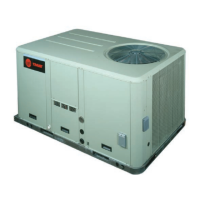Sequence of Operation
RT-SVX21AC-EN 57
modes (Economizer Only, Economizer +1st Stage Cooling,
or Economizer + 1st/2nd Stage Cooling).
The ECA continues to modulate the economizer damper
op
en/closed to keep
the mixed air temperature that is
calculated by the RTRM.
If economizing is not possible, the ECA drives the damper
to the mi
nimum position setpoint when the indoor fan
relay (F) is energized and allows mechanical cooling
operation.
When the unit is equipped with the
optional fan failure
switch, wired between terminals J7-5 and J7-6 on the
RTOM, the RTRM will stop all cooling functions and
produce an analog output if the fan failure switch (FFS)
does not open within 40 seconds after a request for fan
operation. When the system is connected to a remote
panel, the “SERVICE” LED will flash when this failure
occurs.
ReliaTel™ Control Dehumidification
Single Compressor Units
On a call for dehumidification, the reheat valve is
energized and the compressor is turned on. When the
humidity control setpoint is satisfied, the valve is de-
energized and the compressor is turned off. If there is a call
for cooling or heating from the space temperature
controller, i.e. zone sensor or thermostat, while in reheat,
the reheat valve is de-energized and the compressor
continues to run, or the heat is turned on. The 3 minute
compressor on and off times are still active during
compressor operation.
Dual Compressor Units
The dehumidification cycle is only permitted above 40ºF
and below 100°F and is not permitted during a heating
cycle or during a demand for 2
nd
stage cooling. Otherwise,
when an installed zone humidity sensor indicates a
relative humidity equal to or greater than the RH set point
as adjusted on the ReliaTel™ options module (RTOM), a
dehumidification cycle is initiated. The sequence of
operation for the dehumidification cycle is identical to that
of the second stage ReliaTel™ cooling cycle, except that
the hot gas reheat valve (RHV) is energized, allowing air
from the evaporator to be reheated. Also, any installed
fresh air damper is driven to minimum position.The
dehumidification cycle is terminated by initiation of a
heating cycle or a 2
nd
stage cooling cycle or when zone
humidity is reduced to 5% below the R.H. set point. In the
absence of a zone humidity sensor input, an on/off input
from a zone humidistat is used to initiate/terminate the
dehumidification cycle.
Dehumidification takes priority over a call for one-stage
cooling.
Heating or two-stage cooling takes priority over
dehumi
dification, and a relative humidity sensor takes
priority over a humidistat.
Dehumidification Coil Purge Cycle
On multiple circuit units with dehumidification/reheat
configured, a purge cycle will be active for compressor
reliability. The purpose of this function is to properly
distribute refrigerant and lubricant throughout the system
by temporarily switching to the unused section of the coil
for 3 minutes (purge cycle). The function operates as
follows:
1. A purge cycle will be initiated after 90 minutes of
acc
umulated compressor run time in only one mode:
cooling or dehumidification, without transitioning to
the other mode.
2. A purge cycle will consist of transitioning to the mode
that h
asn’t run
in 90 minutes of total compressor
operation. The cycle will last for a period of 3 minutes.
3. The 90-minute cycle count will b
e reset anytime th
ere
is a normal transition between cooling and
dehumidification. Transitioning from one of these
modes to any other mode (off or heat) will not reset the
counter.
4. If the purge cycle is a cooling cycle, only the first circuit
wil
l be
activated. If it is a dehumidification cycle then
the normal 2-compressor dehumidification mode
cycle will be used.
5. The purge cycle will ignore the low ambient
de
humidi
fication lockout feature.
6. A purge cycle takes priority over normal cooling or
de
humidi
fication requests, but will discontinue for all
high priority lockouts and alarms.
ReliaTel™ Control Cooling with an
Economizer
The economizer is utilized to control the zone temperature
providing the outside air conditions are suitable. Outside
air is drawn into the unit through modulating dampers.
When cooling is required and economizing is possible, the
RTRM sends the cooling request to the unit economizer
actuator (ECA) to open the economizer damper. The RTRM
tries to cool the zone utilizing the economizer to slightly
below the zone temperature setpoint. If the mixed air
sensor (MAS) senses that the mixed air temperature is
below 53°F, the damper modulates toward the closed
position. If the zone temperature continues to rise above
the zone temperature setpoint control band and the
economizer damper is full open for 5 minutes, the RTRM
energizes the compressor contactor (CC1). If the zone
temperature continues to rise above the zone temperature
setpoint control band and the economizer damper is fully
open, the RTRM energizes the compressor contactor
(CC2).
The ECA continues to modulate the economizer damper
o
pen
/closed to keep the mixed air temperature that is
calculated by the RTRM.
If economizing is not possible, the ECA drives the damper
to the mi
nimum position setpoint when the indoor fan

